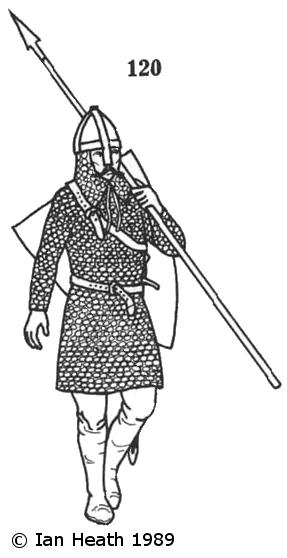
POLISH HEAVY INFANTRYMAN, 13th CENTURY
An extract from Armies of Feudal Europe 1066-1300by Ian Heath

120. POLISH HEAVY INFANTRYMAN, 13th CENTURY
Armour was now generally heavier, though still relatively few wore actual mail. This figure wears a substitute form of body defence that was unique to Poland, comprising a leather jerkin and coif with iron rings sewn all over them, fragments of such armours having been found by archaeologists. Others continued to wear armour similar to that of the last two figures, equipment such as that worn here probably indicating a member of a wealthy nobleman's retinue or one of the relatively well-equipped town militiamen. Tarczownicy arms had not changed except that a sword now frequently replaced the axe as secondary armament. The shield is of standard Western European design, though a large oval type, similar to the circular shield of figure 117 with boss and cruciform reinforcement, also appears during this era, in use amongst peasants as well as shield-carriers.
Some heavy infantry had also by now adopted the crossbow, though many of these were probably of mercenary origin (probably Germans) since this weapon was not at first popular in Poland. However, some of the lighter cavalrymen in the retinues of Polish knights were to be found using crossbows in the 13th century.